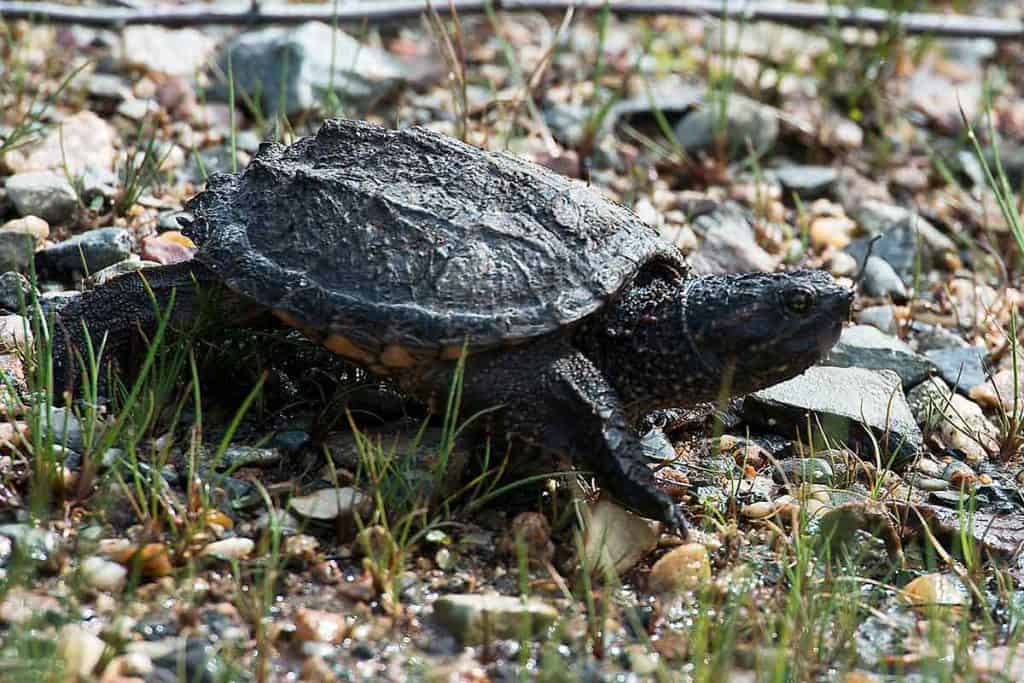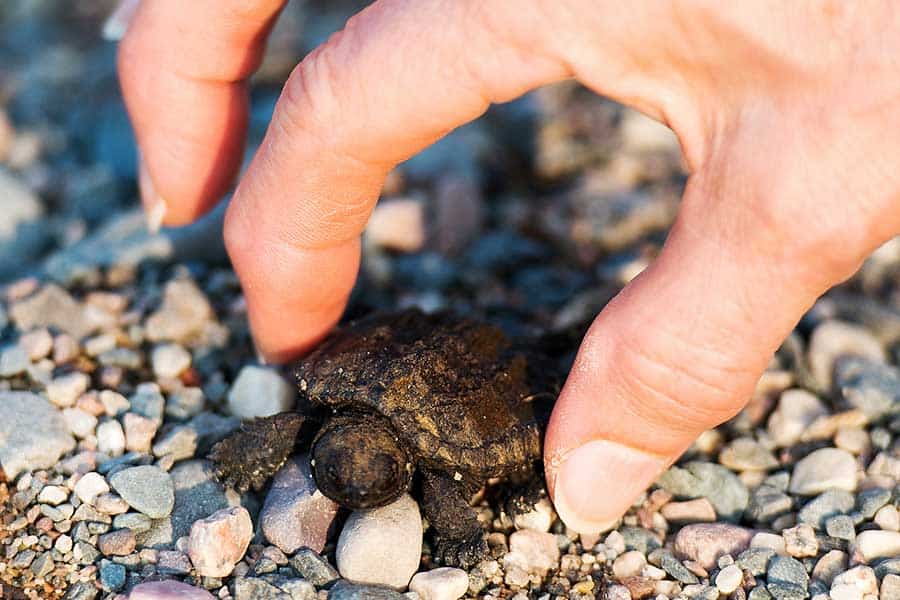Snapping turtles are endangered in the wild. Fortunately, many people have taken it upon themselves to help boost these unique reptiles’ population numbers by breeding them and keeping them. If you’ve just adopted one as a pet, one of the first things you should know is what baby snapping turtles eat.
As far as their diets go, snapping turtles are omnivores. This means they eat both plant and animal matter. Additionally, baby snapping turtles have a similar diet to adult snapping turtles! This makes feeding them simple and straightforward because the diet is familiar to you and does not change much over time.
Feeding your snapping turtle is a task that will become one of your favorite things to do because snapping turtles are always ready to eat and will, as their name suggests, snap up anything in front of them! Baby snapping turtles in particular use large exaggerated movements while eating, which makes them extra fun to watch.
Read on to find out what, how, and when to feed your snapping turtle!
What Do Snapping Turtles Eat in the Wild?
Snapping turtles are opportunistic omnivores. This means that they will eat a wide variety of animal and plant matter they find in the wild, and they are not too picky about what they put in their mouths!
Algae, water lettuce, and lily pads are all often chomped on by hungry snapping turtles if there is no animal protein around.
However, in the wild, snapping turtles would usually rather have a meaty meal than a vegan dinner. Their diet can include worms, frogs, rodents, insects, shrimp, carrion, spiders, snakes, and even other turtles! The rule they follow is that if the prey is small enough, they will eat it!
How Do Baby and Adult Snapping Turtle Diets Differ?
Baby snapping turtles share the same dietary requirements as adult snapping turtles with a few minor differences.
Baby snapping turtles need more animal protein than plant matter in their diet because they are growing rapidly and need a bit of extra energy from their protein to sustain said growth.
The other difference that will limit your baby snapping turtle’s diet is the size of the food items you offer them. Snapping turtles can only eat food that is no larger than the space between their eyes. If the food item is larger than this, there is a large chance of impaction, choking, or other digestive issues.
Plant Matter for Your Baby Snapping Turtle
Baby snapping turtles need a diet that is balanced according to their needs. Their diet should be made up of around 70% meat and 30% plant matter. The plant matter they eat needs to count! This means it needs to be high in
Phosphorus and oxalates block the absorption of
Safe plant material includes:
- Lily pads
- Water lilies
- Moss
- Algae
- Water lettuce
- Dandelion greens
- Collard greens
- Duckweed
- Waterweed
Safe vegetables and fruits include:
- Carrots
- Sweet potatoes
- Bell peppers
- Bananas
- Apples
- Pears
- Blackberries
- Strawberries
- Carrots
- Zucchini
- Zucchini flowers
Keep in mind fruits should be used as occasional treat items, as they are very high in natural sugars, which can lead to obesity and gum rot. Only around 5% of your snapping turtle’s total diet should be made up of fruit.
Fresh, raw plant matter is always best, as cooking the plant matter will reduce the nutrients that your snapping turtle will get.
Always chop the plant matter into small pieces so your snapping turtle does not choke or develop digestive impaction.
Animal Matter for Your Baby Snapping Turtle
Snapping turtles can eat a vast array of animal protein sources. When they are babies, snapping turtles will need fairly small prey items that are appropriate for their size.
Some good choices for baby and juvenile snapping turtles are:
- Crickets
- Dubia roaches
- Hornworms
- Bloodworms
- Tubifex
- Shrimp
- Mealworms
- Tadpoles
- Pollywogs (large tadpoles)
As your baby snapping turtle gets older, they will need to eat larger prey items. Good prey items to include in your adult snapping turtle’s diet are:
- Mouse pinkies
- Rat fuzzies
- Frogs
- Newts
- Snails
- Slugs
- Nightcrawlers
- Feeder fish
- Chunks of chicken and turkey
- Chunks of beef heart and liver
What Supplements Do Baby Snapping Turtles Need?
Even if they have the perfect diet, your baby snapping turtle will still need additional vitamin supplements in their diet. They are growing rapidly, so they need extra help.
Your snapping turtle will need a
A lack of
Metabolic bone disease is especially bad for turtles and tortoises because their bones are their shells, and a soft, brittle shell means they have no protection of their internal organs.
What Commercial Food Do Snapping Turtles Eat?
Adding commercial turtle food to your snapping turtle’s daily diet is a great way to add bulk to their food as well as add basic nutrition.
Aquatic turtle pellets, for example, are great additions to your baby snapping turtle’s daily regime. They float on the surface of the water which means your snapping turtle gets to work for their food which is an enrichment exercise.
What Foods Should You Never Feed Your Baby Snapping Turtle?
There are a number of food items that you should not feed your snapping turtle whether it is a baby or an adult. These items are either toxic or not nutritious enough to benefit your turtle in any way.
Here’s what to keep in mind when it comes to foods to avoid:
- You should never feed your baby snapping turtle any plant matter that has not been washed and rinsed thoroughly. Turtles are very sensitive to insecticides and herbicides.
- Rhubarb, avocado, citrus fruit, and spicy peppers are all highly toxic to turtles.
- Cucumber, watery leaves like iceberg lettuce, and celery are all high in water but low in anything else. They are nutritionally poor and can cause diarrhea and bloating in turtles.
- Any insects that are bioluminescent (i.e. they glow or produce light), such as lightning bugs and glow worms, are toxic to turtles.
- In addition, you should never feed your snapping turtle insects that you have caught in your garden. These can also be coated in harmful toxins like insecticides and pesticides or carry parasites.
Snapping turtles should also never be fed human food, as it often contains preservatives and other chemicals that, while not especially harmful to us humans, are very toxic to turtles.
FAQs About Feeding a Baby Snapping Turtle
When should I feed my baby snapping turtle?
Snapping turtles are nocturnal animals. They should be fed in the evening before they become very active. They need this time to digest their food. If they are fed right before they start resting for the day (in the morning), then the food will sit in their systems undigested.
How often should I feed my baby snapping turtle?
You should feed your baby snapping turtle one large meal a day. They will need a selection of food that is roughly the size of their shell. Alternatively, you can offer your snapping turtle as much food as they want for 20 minutes. After 20 minutes is up, remove all food from their enclosure.
Feeding your baby snapping turtle any less will hamper their growth. However, feeding them too much or too often will lead to obesity, which shortens their lifespan.
Once your snapping turtle is a grown adult, then you can feed them on alternating days. However, they will need much more food. The same rule of thumb applies here in that their meal should be about the same size as their shell.
How should I feed my baby snapping turtle?
Feed your baby snapping turtle in a separate dish designated for feeding, as they can be a bit messy.
Snapping turtles are aggressive, opportunistic predators, and they can turn their heads almost completely around, which means your fingers are never safe!
When feeding your snapping turtle, you should do it using long, sturdy feeding tongs. This way, your fingers stay safe, and your snapping turtle gets a full meal minus human flesh.
What does a baby snapping turtle look like?
Baby snapping turtles are rather odd-looking. They are dark brown and have very little variation.
Their shells are very flat and spiky, which makes them look a bit like squashed rocks. Baby snapping turtles have carapaces (the top part of the shell) that are slightly concave.
Baby snapping turtles also have long necks that they can stick out quite far. Out of the other end of their shell sticks their alarmingly long tail!
Snapping Away on Feeding Snapping Turtles…
What do baby snapping turtles eat? Everything they can fit into their mouths! Baby snapping turtles have voracious appetites on top of being opportunistic and aggressive hunters. This means that anything that crosses their path that looks remotely like food will be chomped!
If turtles are your thing but you aren’t sure you want a snapping turtle, then have a look at our list of best pet turtles you can adopt!




